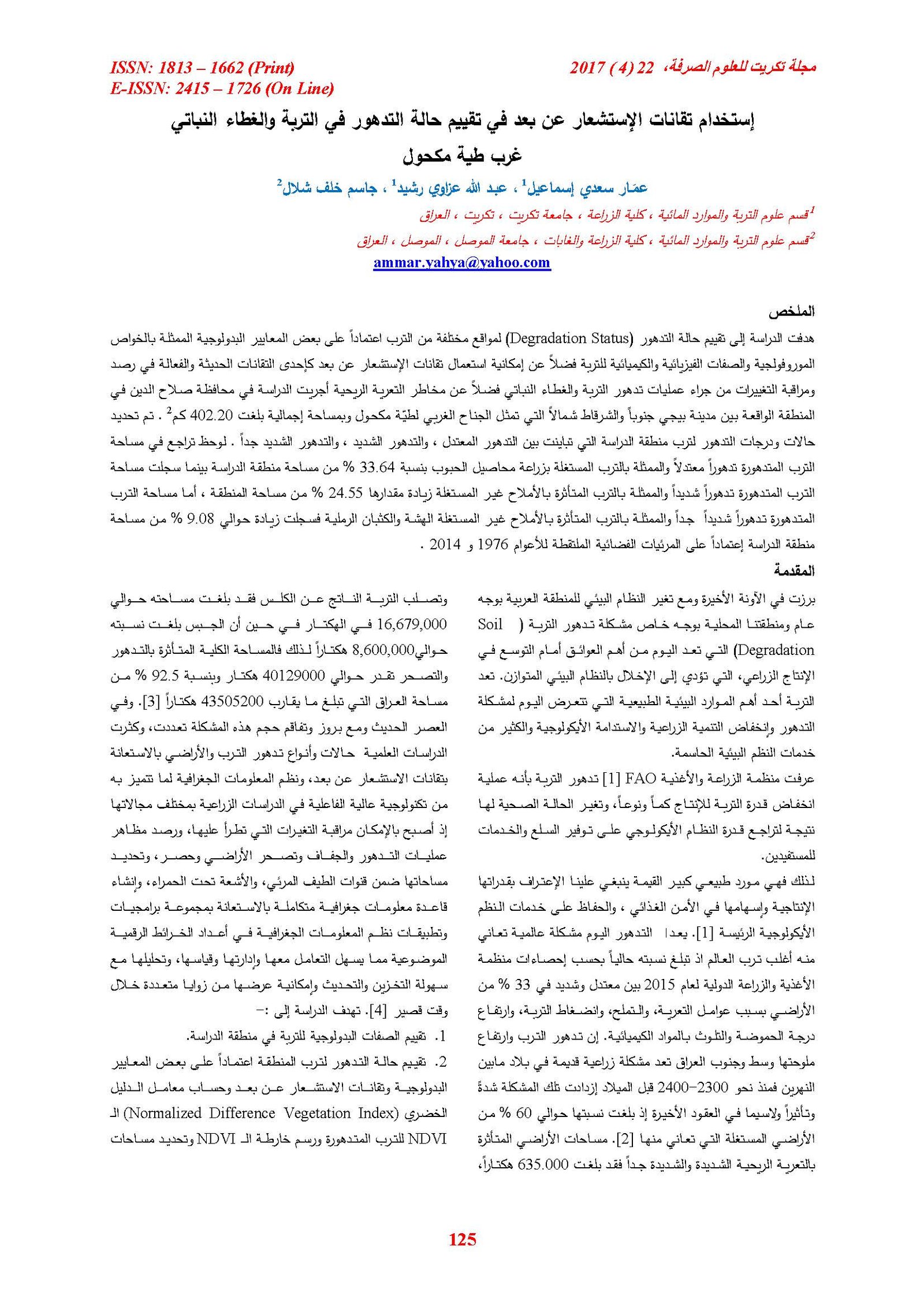Useing of Remote SensingTtechnologies in Assessing Degradation of Soil and Vegetation Cover West Fold Makhoul
Main Article Content
Abstract
This study aimed to assess the state of deterioration (Degradation Status) to different sites of the soil, depending on the possibility of the use of remote sensing as one of modern technologies, and effective monitoring and control of the changes that you get the natural resources of soil degradation and vegetation operations as well as the risk of wind erosion study was conducted in the province Salah al-Din in an area between the city of Baiji, Sharqat south and the north, which represents the western flank of the fold Makhoul total area amounted to 402.20 km2. And was able to study with the help of technologies for remote sensing of determining the status and degree of deterioration of the soils study, which varied between moderate deterioration region, and severe deterioration, very severe degradation. The study confirmed that there is a decline in soils degraded area deteriorated moderate and actress soils untapped cultivation of grain crops increased by 33.64% of the study area space while soils degraded area recorded a severely degraded and actress soils affected by salts untapped increase of 24.55% of the area of the region, while the soils degraded area deteriorated very strong and actress soils affected by salts untapped fragile dunes was registered an increase of about 9.08% of the study area, depending on the area of the space visuals captured for the years 1976 and 2014 .
Article Details

This work is licensed under a Creative Commons Attribution 4.0 International License.
Tikrit Journal of Pure Science is licensed under the Creative Commons Attribution 4.0 International License, which allows users to copy, create extracts, abstracts, and new works from the article, alter and revise the article, and make commercial use of the article (including reuse and/or resale of the article by commercial entities), provided the user gives appropriate credit (with a link to the formal publication through the relevant DOI), provides a link to the license, indicates if changes were made, and the licensor is not represented as endorsing the use made of the work. The authors hold the copyright for their published work on the Tikrit J. Pure Sci. website, while Tikrit J. Pure Sci. is responsible for appreciate citation of their work, which is released under CC-BY-4.0, enabling the unrestricted use, distribution, and reproduction of an article in any medium, provided that the original work is properly cited.
References
5- Soil Survey Staff. (1993). Soil Survey Manual, USDA. Handbook no 18,US Government printing office Washington. D.C.20402.
6- Kilmer, V.J., and Alexander, L.T.(1949). Method of making Mechanical Analysis of Soils. Soil. Sci. 68:15-24.
7- Black,C.A.(1965). Methods of Soil Analysis. Amer.Sco of Agron.No.9 part 2 Madson Wisconsin (U.S.A).
8- Richards, L.A. (Ed). (1954). Dignosis and Imporvement of Saline and Alkali Soils. Agriculture Handbook 60.USDA.
9- Savant, N. K. (1994). Simplified Methylone Blue Method for Rapid Determination of CEC of Mineral Soil. Soil Sci. Plant. Anal.25:3356-3364p.
11- Jackson, M.L.(1958). Soil chemical Analaysis. Prentic- Hall Inc. Engle wood, Cliffs, N.J.
12- Rouse JW, J.R Haas R. H., Schell J. A., D. W. Deering.(1973). Monitoring the Vernal Advancement and Retrogradation (green wave effect) pf Natural Vegetation, Program Report RSC 1978-1. Remote Sensing Center, Texas A and M Univ., College Station.
13- Crippen, R. E.(1990). Calculating the Vegetation Index Faster. Remote Sens. Environ.34:71-73. Formation RTT, Godron, M. (1986). Landscape Ecology. Wiley, New York.
16- Al Ansari., Nadhir A. (1972). Geology of the Southern of Jabal Makhul (Quadrangles NI-38-0196). M.Sc. Thesis College of Science, University of Baghdad , Iraq.
17- Gile, L. H.(1961). Classification of Ca- horizon of Desert Region, New Mexico. Soil Sci. Soc. Am. Proc. 30:52-61.
20- AlZubaidi, A.H.(1974). Chemical Characteristics of some Iraqi Soils Pedology. (19) 1:65-148.
21- Dregne, H. E.(1976). Soils of Arid Regions. Amsterdam, Elsevier Science. Puplising Company Amsterdam, Oxford New York.
26 - Liao, M., L. Liu, P. Zhu, J. Yang.(1999). The Data set of 1-km Resolution Monthly NDVI in China. Towards Digital Earth. Proceedings of the International Symposium on Digital Earth. Science Press.
27 - Sun, Q.(2010). An ERADAS Image Processing Method for Retrieving LST and Describing Urban Heat Evolution: A Case Study in the Pear River Delta Region in South China.
28- Shallal, J.K. (1992). Application of Remote Sensing in Study of Desertification and Soil Degradation. Ph. D. Thesis, Univ. of Brno, Czechoslovakia.
29- Younes, A. H., and M. Abdel- Hady. (2006). Evaluation of Soil Degradation in Northern Sinai (Egypt), Using Remote Sensing and GIS Techniques. National Center. Soil and Water Docki, Giza, Egypt.
30- Dregne, H.E. (1983). Desertification of Arid Lands. Advance in Desert and Arid Land Technology and Development.
